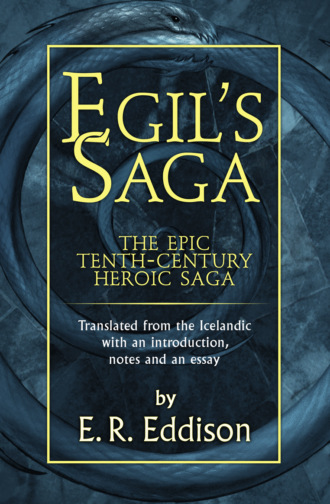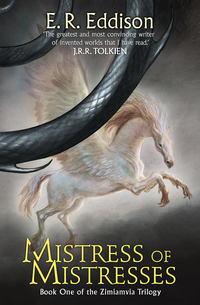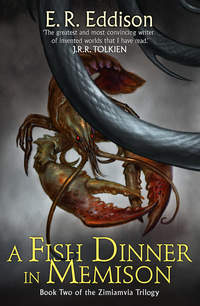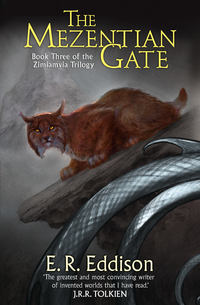
Полная версия
Egil’s Saga


Copyright
Published by HarperCollinsPublishers Ltd
1 London Bridge Street
London SE1 9GF
www.harpercollins.co.uk
Copyright © E. R. Eddison 1930
Maps copyright Gerald R. Hayes 1930
Jacket illustration © HarperCollinsPublishers Ltd. 2014
E. R. Eddison asserts the moral right to be identified as the author of this work.
A catalogue copy of this book is available from the British Library.
All rights reserved under International and Pan-American Copyright Conventions. By payment of the required fees, you have been granted the non-exclusive, non-transferable right to access and read the text of this e-book on screen. No part of this text may be reproduced, transmitted, down-loaded, decompiled, reverse engineered, or stored in or introduced into any information storage and retrieval system, in any form or by any means, whether electronic or mechanical, now known or hereinafter invented, without the express written permission of HarperCollins.
Source ISBN: 9780007578092
Ebook Edition © 2015 ISBN: 9780007578108
Version: 2015-05-07
To
MY DAUGHTER
JEAN
AND TO A NOBLE ICELANDIC LADY,
SVAVA ÞÓRHALLSDÓTTIR
OF Hvanneyri
I DEDICATE THIS BOOK
CONTENTS
Cover
Title Page
Copyright
Dedication
Preface
Introduction
Chap. I. Of Kveldulf and his sons
II. Of Oliver and Solveig
III. The uprising of King Harald Hairfair
IV. Of the battle off Solskel
V. Of King Harald’s sending to Kveldulf
VI. How Thorolf Kveldulfson went to King Harald
VII. Of Biorgolf and Bryniolf, and of the beginnings of the sons of Hildirid
VIII. Of Thorolf and Bard Bryniolfson
IX. Of the battle of Hafrsfirth
X. Of Thorolf’s Finn-faring
XI. Of the faring of King Harald into Halogaland and his guesting with Thorolf Kveldulfson
XII. Of the evil speech of those sons of Hildirid
XIII. Of Thorolf’s sending of the scat to King Harald and gifts therewith
XIV. Of Thorolf’s second faring into Finnmark
XV. Of more lies and slanders of those sons of Hildirid
XVI. Of Thorolf Kveldulfson and the King
XVII. Of Hildirid’s sons and their gathering of the Finnscat, and of their new lies and slanders
XVIII. Of the King’s sending of two brethren and their robbing of Thorolf’s ship
XIX. Of Thorolf’s harrying in the Wick and of counsel given him by Kveldulf
XX. Of Skallagrim’s wedding
XXI. Of rede taken for an onset against Thorolf
XXII. The fall of Thorolf Kveldulfson
XXIII. The slaying of Hildirid’s sons
XXIV. The sorrow of Kveldulf
XXV. Of Skallagrim’s going to the King
XXVI. Of the children of Duke Gutthorm
XXVII. Of the slaying of Hallvard and Sigtrygg: and how Kveldulf and Skallagrim fared to Iceland
XXVIII. Of Skallagrim’s land-taking
XXIX. Of the works of Skallagrim
XXX. Of the coming out of Yngvar, the father-in-law of Skallagrim
XXXI. Of the children of Skallagrim
XXXII. Of Biorn Bryniolfson and Thora Jewel-hand
XXXIII. Of Biorn’s faring to Iceland
XXXIV. Of Skallagrim and Biorn
XXXV. Of the birth of Asgerd: and how Thorolf Skalla-grimson went with Biorn to Norway
XXXVI. Of the King’s son Eric, and Thorolf Skalla-grimson
XXXVII. Eric Bloodaxe in Biarmaland
XXXVIII. Thorolf cometh home to Iceland
XXXIX. Thorunn Skallagrim’s daughter given in marriage
XL. Of Egil’s childhood and upbringing
XLI. Of Biorn and Thorolf and King Eric; and of Egil and Arinbiorn
XLII. Of Thorolf’s wedding with Asgerd
XLIII. Egil in Atley
XLIV. Of Bard’s slaying
XLV. Of Egil’s flight
XLVI. Thorolf and Egil harry in Kurland
XLVII. Thorolf and Egil harry in Denmark
XLVIII. Of guesting with Earl Arnfid: and how Thorir the Hersir spake with the King concerning those sons of Skallagrim
XLIX. Of the dealings betwixt Egil and Eyvind Braggart
L. Thorolf and Egil in England
LI. Of Olaf the Scots-King, and others
LII. Of Olaf the Scots-King’s warring against England
LIII. The battle on Winaheath
LIV. The second day’s battle on Winaheath: with the fall of Thorolf Skallagrimson
LV. Egil in King Athelstane’s hall
LVI. Of Egil’s wedding and of his home-coming; and of his faring abroad the second time and his suit against Bergonund at the Gula-Thing
LVII. Egil made outlaw from end to end of Norway: of his vengeance taken upon Bergonund and others, with how he laid a Scorn upon King Eric and the Queen and came home again to Iceland
LVIII. Of the death of Skallagrim
LIX. Of Egil’s faring abroad the third time: with how he was cast ashore in England and was fallen into the hand of King Eric Bloodaxe and Queen Gunnhild
LX. How Egil quoth his drapa that is named Head-ransom in King Eric’s hall in York
LXI. Of Egil’s life given him by the King
LXII. Of Egil’s faring to Norway with Thorstein Ericson, the sister’s son of Arinbiorn the Hersir
LXIII. Of Egil and King Hakon Athelstane’s-fos-terling
LXIV. Of Egil’s coming to Fridgeir’s, and of his dealings with Ljot the Pale
LXV. Of the dealings betwixt Egil and Atli the Short
LXVI. Of Egil’s home-coming and dwelling in Iceland: the children of him and of Asgerd
LXVII. Of Egil’s going abroad once more to Norway, and his guesting with Arinbiorn in the Firths
LXVIII. Of Egil’s claiming of the heritage of Ljot whom he had slain, and how Arinbiorn brought that claim before King Hakon, and with what issue
LXIX. Of the harrying of Egil and Arinbiorn in Frisland, and of their parting
LXX. Of the Vermland scat, and how King Hakon would send Thorstein Thorason to get it in, other else to get him gone out of the land
LXXI. Of Egil’s journey into Vermland and his guesting with Armod Beard
LXXII. Of Egil’s leave-taking of Armod, and his coming to Thorfinn’s
LXXIII. Of Egil’s coming to Alf the Wealthy
LXXIV. How Egil came to Earl Arnvid and had the scat of him, and of the Earl’s charge unto his men concerning Egil
LXXV. Of Egil’s bringing of the scat out of Vermland and of his great fights against the Earl’s men that sat for him in Eidwood
LXXVI. Of the bringing of the Vermland scat to King Hakon, and of the King’s faring into Vermland and those eastern parts, and of Egil’s coming home to Iceland
LXXVII. Of the burning of Thord Lambison; and of the giving in marriage of Thordis, Egil’s step-daughter, to Grim of Mossfell
LXXVIII. Of the wedding of Thorgerd, Egil’s daughter, to Olaf the Peacock: of Egil’s loss of his sons Bodvar and Gunnar; his Sons’ Wreck and his Arinbiorn’s Lay; and of his old age in Iceland and the friendship betwixt him and Einar Jingle-scale
LXXIX. Of Thorstein Egilson, and of the death of Asgerd, Egil’s wife, and how Egil shifted house from Burg to Mossfell
LXXX. Of Steinar, the son of Onund Sjoni, and his high-handed dealings with Thorstein Egilson
LXXXI. Of the slaying of Thrand, and of the suit at law betwixt Steinar and Thorstein
LXXXII. Of Egil’s award in the suits between Steinar and Thorstein
LXXXIII. How Steinar sat for Thorstein Egilson beside Einkunnir
LXXXIV. Of the end of the dealings between Steinar and Thorstein Egilson
LXXXV. Of the last days and death of Egil Skalla-grimson
LXXXVI. Of the finding of Egil’s bones
LXXXVII. Of the Myresmen’s kin that are come of Egil’s blood and line
GENEALOGICAL TREES
CHRONOLOGICAL TABLE
LIST OF ABBREVIATIONS
TERMINAL ESSAY: ON SOME PRINCIPLES OF TRANSLATION
NOTES:
I. Books for English Readers
II. Berserk
III. Shape-strong
IV. General Note on the Verses
V. The Scorn-Pole
VI. Earl Hakon the Great
Miscellaneous Notes
INDEX
MAP OF NORWAY IN THE SAGA-TIME
MAP OF THE COUNTRYSIDE ABOUT BURGFIRTH
Also by E. R. Eddison
About the Publisher
PREFACE
EGIL SKALLAGRIMSON of Burg is the main actor in this history, not its author. Who its author may have been we do not know, and probably never shall. The time is a thousand years ago: the place the northlands, generally Norway or Iceland. Certain famous scenes (the battle of Winaheath and the great drama of the Höfuðlausn in Eric’s hall at York) are staged in England, and this in itself may be thought to give this saga a special interest to English readers. But quite apart from such accidents of staging, no Englishman, I think, can read the book attentively without becoming aware that this is not a foreign book but curiously his own, curiously English. The accent and manner of the story, the characters in it, their instincts and reactions and, in a subtle and fundamental way, their whole outlook on life, seem native to us; and if this is surprising it is only because we have grown accustomed to regard as distinctively English many qualities that have come down to us through the Norse strain in our ancestry.
The present edition is meant first for the man in the street, and only secondarily for the expert or scholar. The Icelandic sagas, of which Egil’s Saga is one of the most important, are documents of interest to inquirers in many fields, history, anthropology, comparative law and custom, philology. That interest they hold in common with a thousand musty chronicles. But the sagas have another quality which they share only with a few of the great literary masterpieces of the world: the quality of vivid, unstaled and undauntable life. If they are to-day, after so many hundred years, still read and re-read in every farmhouse in Iceland, it is from no obsession with the bones of a dead past, but because the sagas are replete with individual character and action; because they are swift, direct, dramatic; because on their pages real men and women play out their everyday existence on the stage of the world uninterrupted by extraneous judgement or comment, and disguised by no specious but false lightings of romance.
The general reader, then, I have had mainly in mind. For his sake I have kept the pages of the translation free from the distraction of footnotes: I have confined the Notes at the end largely to points the elucidation of which is helpful towards the fullest enjoyment of the story and (a very different and much more troublesome matter) an understanding of the verses which occur here and there: I have included in the Introduction such general facts about the settlement of Iceland by the Northmen, the state of society in the North in the heroic age, and the nature of the classic literature as such a reader may be interested to know of if he takes up the book with no previous knowledge of the subject. Further I have, by the addition of genealogical trees, chapter-headings, and a carefully framed index, done all I could to smooth away what is the only serious obstacle met with on a first acquaintance with the sagas: the difficulty on a first reading of carrying in one’s mind the many different persons, and sorting out the major from the minor characters.
Egil’s Saga has not hitherto been available to English readers. A previous attempt to translate it was made, some thirty-five years ago, by the Rev. W. C. Green. It is to be feared that the translator little understood the qualities of his original or the difficulties of his task. His version (now out of print) in its flaccid paraphrasing, its lack of all sense of style, its latinized constructions, and (a comparatively venial offence) its foolish and unavowed expurgations, conveys no single note or touch of the masterpiece with which he was dealing.
I have based my translation on Dr Finnur Jónsson’s text in his latest edition published at Copenhagen, 1924.
I wish to place on record my obligations to the many people who have helped me in this work. First, to Mr Bogi Ólafsson, teacher of English in the Grammar School at Reykjavik, who has given me the inestimable assistance of his criticisms of my renderings after reading the whole of my manuscript through in its first draft. Thanks to his generous help, I can at least be sure that my text is free from the grosser mistakes which must otherwise have crept into it. Secondly, to Professor Sigurður Nordal, whose own new annotated edition of the original was unfortunately not available in time for me to make use of it in preparing my Notes. He has however kindly read in MS both the Introduction and the Terminal Essay, in both of which, and in the Notes, there is much that owes its existence to his inspiration and learning. Among others to whom I am indebted are Dame Bertha Phillpotts, for her constant interest and encouragement; Sir Henry Newbolt; Professor Haakon Shetelig; and Mr Gerald Hayes for the beautiful maps he has designed and given me. I also thank Dr Finnur Jónsson, for courteously authorizing me to make use of the valuable material embodied in his editions of Egils Saga; Messrs Bernard Quaritch, for giving me full authority to quote from their Saga Library, which, besides containing Morris’s magnificent (indeed, the only readable) translations of such important sagas as the Ere-Dwellers (Eyrbyggja) and the Heimskringla, affords in its concluding volume a mine of useful historical and critical information; Messrs Longmans Green and Co. and the Trustees of the late William Morris, for allowing me to quote from Grettir the Strong and Three Northern Love Stories; Professor E. V. Gordon and the Clarendon Press for permission to quote a passage from his Introduction to Old Norse; Messrs Longmans (again), the Syndics of the Cambridge University Press, and Count Hermann Keyserling together with his publisher, Mr Jonathan Cape, as regards quotations from R. L. Stevenson, the Cambridge Medieval History, and the Travel Diary of a Philosopher respectively. To Mr Cape I am also obliged for his agreement to my including in the Introduction my version of part of the Völospá, originally printed in my historical novel Styrbiorn the Strong. Finally, I am grateful to Mr Walter de la Mare for letting me use on a fly-leaf (see here) words of his which, though written in another context, sum up far better than could any words of mine the peculiar genius of the sagas.
Of Egil’s personal character the saga and the specimens of his own poetry which it preserves can speak more eloquently than any latter-day translator. I will only say that the school of criticism which questions the veracity of the saga on the ground that (for example) the gouger out of Armod’s eye could not in nature be also the tender and sublime poet of the Sonatorrek, is a school that knows little of humanity. In his pride, his reckless violence, his selfishness, as well as in his love of his art and in his simple faith that God is on his side and that those who disagree with him are therefore patently hostes humani generis, he stands side by side with Benvenuto Cellini. It is never to be said of Egil, whatever his faults, that he was a little man; or a liar; or a man without “kinship with the stars”.
E. R. E.
71, BEDFORD GARDENS
CAMPDEN HILL, W.
September 1930
Μυάσεσθαί τινά ϕαμι καὶ ὔστερον ἅμμεων.
SAPPHO
“Not one overt word of horror or of warning or of admonishment, only the bare clear record; but beyond it the poising of scales so delicate and so sure that the secrets of every heart are revealed and the judgement never in doubt.”
WALTER DE LA MARE
(from Desert Islands: on the romance enshrined in the Old Testament)
INTRODUCTION
THE HEROIC AGE AND THE SAGAS
OF the five major Íslendinga Sögur (Njála, Egla, Laxdæla, Eyrbyggja, and Grettla) Egil’s is at once the most aristocratic in spirit, the most pagan, and (with the single exception of Njála) the most perfect as a work of art. That is as much as to say that it is, of all five, the most typically Icelandic. For Iceland means three things: first, on the political field—aristocratic individualism of an uncompromising kind; secondly, in its broad outlook on human life and destiny—paganism; and thirdly, in art—a peculiar and in itself highly perfected form of prose narrative. When we consider that the growing time, the flowering and the decay of this Iceland were comprised within a period beginning in the ninth century in the reign of Alfred the Great, and ending in the thirteenth, it is clear that the whole thing was only made possible by the accident of the physical isolation of Iceland from the rest of Europe. For there was no room in mediaeval Europe for an aristocracy not feudal but anarchical, or for a paganism so deep and so tolerant that it lived on, essentially unchanged, for generations after it had adopted as its own the formulas and practices of Christianity. These things could not have developed in a society exposed at close quarters to the huge impersonal ideals of Empire and Papacy and to the all-embracing system of dogma and ethic of the mediaeval church; while the dead weight of Latin culture made it impossible for an original literature, owing nothing to Greece or Rome, to spring up and attain to classic perfection in the vulgar tongue.
It is as a background to Egil’s Saga, which is the main figure in our picture, that I propose now to sketch roughly what seem to me the essential features of this profoundly interesting piece of landscape which, in the country of the mind, we may call Iceland. The sketch must be meagre and inadequate; it contains, I am afraid, nothing that is new; but I shall do my best to see that it contains nothing that is not true.
THE REPUBLIC
Politically, we may say that it was King Harald Hairfair who created the Icelandic commonwealth; not by his will, indeed, but by his act. He broke down by conquest the old order in Norway, and raised up in its place a central and autocratic power wielded by himself as sole King through subordinates, his own creatures and instruments. To the old nobility this change was the greatest of evils: in every folkland instead of their old folk-king, not much beyond themselves in power and honour, to whom they owed a loose allegiance and upholding in war, they were now faced with Harald’s earl and tax-gatherer. Most hateful of all was the King’s claiming of the odal rights, the freehold land-rights by which the land followed the family from generation to generation. He took away these odal rights, and gave them back only in return for taxes and other services. The great men (including small kings, earls, hersirs, and landowners of lesser rank) had therefore the choice of three things: to withstand the King in battle, to renounce their freedom and become his men, or to flee the land. The first was shown by repeated experience, extending over some twelve years and ending with the great sea-fight at Hafrsfirth, to be impossible. The second was accepted by many. But there were large numbers who preferred the third choice, to leave the country. “Because of that unpeace many noble men fled from their lands out of Norway; some east over the Keel, some West-over-the-sea. Some there were withal who in winter kept themselves in the South-isles* or the Orkneys, but in summer harried in Norway and wrought much scathe in the kingdom of Harald the King” (Eb. 1)†. But after Hafrsfirth, Harald cleared out the vikings in their western lairs and set his own earls in the Orkneys. Men had then to turn their eyes to more distant lands, and it was at this time, about 874, that Iceland was discovered. To that hard and lonely island in the high Atlantic there was for the next two generations an almost continuous stream of settlement from Norway, both direct and by way of the western lands. By the end of that time the country was stocked with a population of perhaps 50,000. A small population: but so was Athens small, and the Greek cities of Ionia. Eugenically, it may be doubted whether any country in history has possessed a population of a higher quality. For the men who settled Iceland were precisely the pick and flower of the Norse race; precisely those whose fierce spirit of independence and freedom could not abide the new ‘enslavement’ in Norway, and who chose loss of lands and goods, and banishment in an unknown country, rather than go under King Harald’s hand. To match the circumstances we must picture the sailing of a Mayflower not in Stuart but in Elizabethan times, and give her for passengers not William Penn and his Pilgrim Fathers, but, driven from England by some strange tyranny till then unheard of, men of the mind and temper of Raleigh and Drake, Sidney and Marlowe.
Thus Harald Hairfair, intent on consolidating his kingdom in Norway, had laid the foundations, far across the seas, of the Ionia of the North. The process is described, not in general terms but vividly in the actions and clashes of individual persons, in the first twenty-seven chapters of our saga. In the tragedy of Thorolf Kveldulfson (Egil’s father’s brother) and in the events leading to the decision of old Kveldulf and his family to leave Norway and start again in Iceland, is gathered up the whole history of the quarrel between the King and the great houses. The new land was apt by nature for the strange republic it was destined to nurture. Habitable enough and generally of a temperate climate in the dales and open country towards the coast, it rose inland to a high central region of dreadful wolds of lava and black sand and stone and fog and snow, where sometimes a traveller must carry every handful of fodder for his horses; for that desert of many days’ journey supports neither man nor beast. There were thus great distances within the land, and great physical barriers, so that each man might in a manner be king in his own countryside: and so, in a manner, he was.
The first settlers (landnámamenn) took land far and wide in the districts where they put in with their ships, if they liked the look of it; afterwards they portioned it out in estates among their friends and dependents, as Skallagrim did with his great land-takings in Burgfirth, chs. XXVIII–XXX. The settler himself was by general acceptance lord of the countryside, and temple-priest. Goði, which is commonly and properly translated ‘priest’, had under the old faith no sacerdotal connotation: the ‘priest’ was squire and parson in one. The position is well illustrated by the account of the settlement of the Thorsness country in Snaefellsness by Thorolf Mostbeard, the greatgrandfather of Snorri the Priest. Thorolf was lord of the island of Most in the west of Norway, and “had the ward of Thor’s temple there in the island, and was a great friend of Thor”. He gave aid to Biorn, an outlaw of King Harald’s, and so came under the wrath of the King. He “made a great sacrifice, and asked of Thor his well-beloved friend whether he should make peace with the King or get him gone from out the land and seek other fortunes. But the Word showed Thorolf to Iceland.” He followed that Word: and when he came in his ship off Iceland, he “cast overboard the pillars of his high-seat, which had been in the temple, and on one of them was Thor carven; withal he spake over them, that there he would abide in Iceland, whereas Thor should let those pillars come aland”. The wooden pillars came aland on the outermost point of a ness in Broadfirth, that has ever since been called Thorsness. “Thereafter Thorolf fared with fire through his land* out from Staff-river in the west, and east to that river which is now called Thors-river, and settled his shipmates there. But he set up for himself a great house at Templewick which he called Templestead. There he let build a temple, and a mighty house it was…. To that temple must all men pay toll, and be bound to follow the temple-priest in all farings, even as are now the thingmen of chiefs. But the chief must uphold the temple at his own charges, so that it should not go to waste, and hold therein feasts of sacrifice” (Eb. 4).








